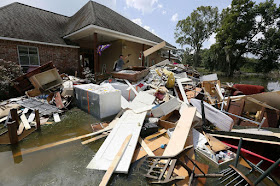With Insurance Claims in the Balance, Flooded Homeowners Fed up With Debris Pickers
People with pickups or even trailers are going through the piles of debris and taking anything of worth in Baton Rouge, La., neighborhoods.
Amy Wold, The Advocate, Baton Rouge, La. | August 29, 2016
In this Aug. 25, 2016 photo, debris from gutted homes line the streets of Baton Rouge, La. AP/Max Becherer
(TNS) - The piles of debris lining the streets of many flooded, Baton Rouge, La. neighborhoods now come with their own signage – “Our crap, not your's,” or “you loot, we shoot,” or even more to the point, “do not touch.”
The signs written on plywood or messages painted on appliances started popping up soon after the flooding subsided and residents had a chance to start cleaning out their homes.
“Right after we put our stuff out, we had people asking if they could take the washer and dryer,” said Kim Halphen, 46, from Walker, who had large “do not touch” signs in front of the house debris. “We can’t get rid of it until the (insurance) adjusters come.”
The problem has received a lot of attention in neighborhoods and on social media where people with pickups or even trailers are going through the piles of debris and taking anything of worth. It has riled many homeowners who are concerned it's hurting their chances of collecting from insurance or FEMA aid.
“They’re rummaging through everybody’s worldly possessions,” said Don Gerard, 60, of Walker.
One evening, Gerard said he drove to his house and saw four men in a pickup loading material from the debris pile and had made it to his house. Gerard asked the men to leave the stuff alone, but they told him they were going to keep looking anyway.
That could be a problem for people, he said, because insurance companies are asking homeowners to save certain things such as pieces of carpet or wood trim.
Andrew Haley, 32, filmed a number of trucks taking away just appliances while he was helping his insurance adjuster parents work in East Baton Rouge Parish Monday
The workers identified themselves as working with FEMA or the city-parish, but Haley said after working a number of flood disasters with his parents, he knew that wasn’t true.
“They’re not cleaning anything up. They’re just taking the appliances,” Haley said. “The insured has no way to get these items paid for.”
Haley said he decided to post the video on Facebook to bring attention to the problem.
“People shouldn’t take advantage of other people in need,” Haley said.
Central’s Mayor Jr. Shelton took a much more firm approach.
“If we catch them, we will arrest them,” Shelton said. “They’re profiting off the backs of tragedy of people.”
Residents should document what is coming out of their homes for insurance purposes, but the piles don’t have to remain intact for FEMA, he said.
“FEMA is not looking at your piles,” he said.
However, trash pickers coming through a neighborhood looking for anything valuable out of people’s yards are like vultures, Shelton said.
It also becomes a safety hazard because people will dismantle piles to get at the stuff they want, leaving material in the streets, he said.
“It’s going to become a bigger problem the longer it (debris) stays on the street,” Shelton said.
Reimbursement for lost household items can follow a couple paths and each has different requirements for documentation depending on whether a homeowner has flood insurance or is going to be applying for FEMA grants.
“Make sure you take your pictures because debris pick up is going on now,” said Karen Khonsari, city-parish director of environmental services in East Baton Rouge Parish.
For insurance purposes, including the National Flood Insurance Program, documentation of household items with photos, serial numbers, makes and models is important and should be done before or directly after something is moved to the curb for disposal, said Kurt Pickering, FEMA media relations manager for the Louisiana flooding recovery.
For those without flood insurance, photos are always a good safety net, but claims can be made even without the documentation, he said. The adjuster can see where the appliances were hooked up and see imprints in the floor along with the water level in the house. Unlike insurance, FEMA grants and assistance would pay the same for a high end dryer as a low end one, so serial numbers are less important.
Not having a photo won’t impact a FEMA grant, he said.
A misconception is that FEMA grants are supposed to cover losses, but it’s not insurance. The FEMA grants are instead meant to help people get back on their feet in a habitable home, but not replace the value of what was lost, Pickering said.
Having appliances taken from yards by people other than the debris contractor is not something he said they’ve seen a lot, but it does happen. However, that has little to do with how much or whether a homeowner can get FEMA assistance, he said.
“The idea that we need to look through a pile is not true,” Pickering said. “It’s not a good idea to have it (debris) sitting outside the house.”



